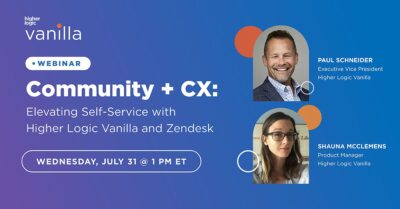
How to Get Executive Buy-In for Community-Based Customer Success
When you approach your executive suite to secure buy-in for a customer community strategy and tools, make sure you have a clear picture of how community supports customer success and business goals. The value of a customer community stretches well beyond self-service product support and industry networking capabilities. It can become the foundation for an improved enterprise customer experience and a proactive, scaled customer success program.
An Online Community Helps Drive Business Outcomes
Having a customer/user community helps customer success managers (CSMs) do their jobs more efficiently – meaning you’re spending less time on repetitive tasks and more time strategically anticipating customer needs and applying a personal touch when it’s most impactful. This elevates your position with your customers from vendor to valued partner. It also helps your company grow without having to exponentially expand CSM resources because the CSMs you do have are equipped to scale their customer success strategy from one-to-one to one-to-many.
When communicating the benefits of community for the business, there are a few key areas to highlight:
Product Adoption
A highly engaged customer community helps your users learn how to leverage your products quickly to achieve their goals, which ensures fast time-to-value. It also gives you a centralized place to share documentation and product updates, as well as monitor for and address questions and confusion. You can provide a knowledge base of documentation in your community to make it easier for users to get up to speed and onboarding managers to coach their team on using the product to its full potential. Users can also learn from other customers and observe a multitude of use cases they can emulate. On top of all that, you can incentivize the actions you’d most like users to take with gamification tools, guiding customers along the ideal customer journey.
Customer Experience
Customer communities help CSMs quickly welcome customers into an active group of like-minded peers with shared challenges and technologies. This helps establish a sense of ownership and belonging. In a world where some customers might feel their technology solution options are basically the same, a robust customer community can be a true differentiator and competitive advantage. With community, when customers consider the benefits of your product, not only calculating the benefits they gain from the product itself, but also from the space you’ve provided for them to engage with their colleagues.
Customer Support
Searchable information and a community of peers willing to help can reduce the number of support tickets and emails you receive. Self-directed customers quickly and easily find answers to their questions or challenges, feel more independent and in control, and are happier for it.
Customer Retention
The results your customers gain from using your product (and their awareness of these results) are a big indicator of churn vs. retention. Having a customer community empowers you to collect case studies that show users how to calculate ROI and illustrate the positive impacts your products have had, which helps your customers stay on top of and defend the benefits of your products when it’s time to renew. You can also look out for unhappy customers who might be sharing their frustration in the community and connect with them before it’s too late.
Customer Expansion
A customer community helps create fertile ground for expansion conversations and decisions. The social proof of hearing from happy peers in the community does more than any salesperson could. Relatively new customers increase their trust and become more willing to deepen the relationship with your brand. They also learn about expansion steps other customers took and how they might build the business case for that expansion within their organization.
The Step-by-Step Guide to Winning Executive Support for Customer Communities
So, what are the specific steps you can take to share the impacts of community with executives and get their buy-in for a community rollout or for additional support for your customer community?
1. Begin with the goal of winning the backing of a single executive.
You’re not going to win over every one of them in one massive swoop, so focus on acquiring one executive sponsor. They’ll be invaluable in winning over the others.
If an executive has already tasked you with developing a customer community plan, congratulations. You have a high-level supporter, but now it’s on you to deliver a winning plan that helps that executive accomplish their intended goal.
If the customer community is all your idea, then you’ll need to determine which executive is most likely to be your lead sponsor. This might be someone you already have a great relationship with, someone you know is already interested in customer communities, or the executive that stands to gain the most if it works.
2. Meet with your executive sponsor on a regular basis as you develop the plan.
Solicit their input and be clear you’re taking all of it into serious consideration. Welcome their expertise and learn from them how you can best sell the initiative to other executives.
3. Strategize with your executive sponsor how you’ll get everyone onboard.
They know the players. They’ll know which issues might be raised. Have answers ready for each of those possible issues. Have assurances ready for any fears they’re likely to have. “Just trust me” is never a good sales pitch.
4. Think about the “show” you’re going to put on.
Consider how many executives you’ll present to at a time, whether you’ll incorporate visual aids, what examples of other companies’ communities might help you make your case, etc.. Make sure you’re prepared for an inevitable Q&A, and consider providing executives either with prep materials, takeaway materials, or both. You should also leave them with clear “next steps” and/or a clear ask at the end of your presentation.
5. Take the emotion out and make a business case.
Walk them through what resources are required and the must-haves vs. nice-to-haves. You should also be clear about how each department will need to contribute and how they will benefit.
6. If you have supporting material to suggest that a community will perform really well with your audience, now’s the time to share it.
You can also explain what metrics will be tracked and what you expect success to look like.
7. Invite input.
Encourage executives to contribute their ideas. People are far more likely to support something if their personal thumbprint is on it.
8. Understand that ultimately, this is their decision to make.
You’re just proposing it after having thoroughly researched it. You want true buy-in, which means each executive is invested in making this work. You don’t want executives who are reluctantly saying yes, but who stand more than ready to say, “I told you so” if you run into any challenges.
9. Hold regular update sessions and reports, both during development and after the rollout.
Each session should be as prepared, passionate, and influential as your initial pitch. Remember it’s not enough to win support, you have to keep it. Invite any new concerns and address each.
10. Be proactive in working with the executives who have special accountability for parts of the plan.
They have plenty of other things going on, so maintain frequent touchpoints and politely advise them of all needs and deadlines.
Remember, executives want the efforts they agree to and that are undertaken to be successful. Don’t interpret questions and pushback as efforts to derail you. See them as desires to make sure your customer community works and brings all the benefits envisioned.
The Ability to Scale Customer Success Could Be Your Strongest Argument
As you’re crafting your executive buy-in pitch, don’t forget the major role an online customer community can play in scaling and maturing your customer success program – a strong selling point.
By facilitating customer connections, communities remove a great deal of the heavy lifting done by customer success teams. This is not a passing of the buck. This is using community to educate customers, disseminate company content and updates, and answer questions more efficiently.
The result: customer success managers are freed up to focus on valuable customer-relationship building.



